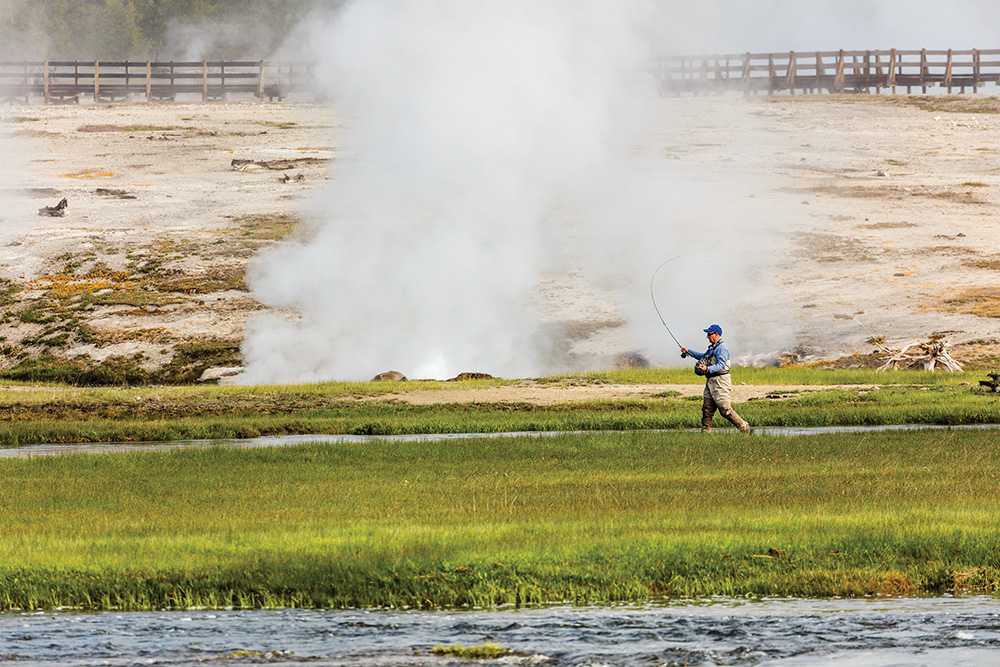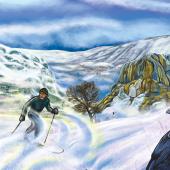Our Time
Yellowstone Park in the year of the Bug.
This past spring was a rough one, but one silver lining for inhabitants of southwest Montana (along with '90s-era traffic and elbow room during the salmonfly hatch) is the opportunity to once again visit our beloved Yellowstone National Park—without the RV lineups, bear jams, busy boardwalks, and over-occupied fishing holes. The usual hordes of tourists—some three million strong these past few years—will dwindle to nearly nothing, leave Yellowstone’s 2.2 million acres blissfully barren of human activity.
This is our time, Bozeman. Go enjoy some of the world’s finest fishing, wildlife watching, hiking, backpacking, and wholesome family time in the Park. Wonderland awaits.
Bear in mind that some facilities could be closed for the 2020 season, including hotels, campgrounds, bathrooms, restaurants, visitor’s centers, and more. A complete list of what’s open and what’s not can be found at nps.gov/yell. Assuming that the rest of the Park will be up and running all summer, here are some opportunities to re-acquaint yourself with Yellowstone.
Fishing
Remember the Firehole? Or the Yellowstone River’s fishy canyons, or Slough Creek’s meadows? All that, plus the dry-fly-eating cutthroat of the Lamar in July and August, the green-drake hatches in the Yellowstone River above the falls, Trout Lake’s cruisers, Gibbon Meadows, and the Madison and Lewis Channel in the fall should be back on the local angler’s radar this summer.
There will definitely be some anglers on the water, from near and far. But at the very least, the reduced traffic will get you there faster, giving you extra time to explore and find your own spot. Better yet, hit some backcountry spots you’ve never fished. Keep your eyes open for discounted guide trips and openings on guided backcountry trips for hinterlands like the Bechler River meadow, the Thorofare, or Heart Lake.

Fishing Firehole
Hiking
Favorite trails can once again be traversed without getting stuck behind retired, slow-moving globetrotters. The Mount Washburn Trail, for example, is accessed via the Dunraven Pass Trailhead between Roosevelt and Canyon Village. This easy-ish six-mile round-trip hike can be done by most and offers quintessential views of the iconic Park landscape.
The spectacular Sky Rim Trail is likely the closest Yellowstone hike to Bozeman, but it isn’t for the out-of-shape at about 18 miles round-trip. It takes hikers up and over mountain passes and peaks, providing 100-mile views of the surrounding glory. It starts on the east side of Hwy. 191 south of Big Sky, about a mile after the big Park entrance sign, which fewer vacationers should be posing next to.
A jaunt into the Black Canyon of the Yellowstone is another favorite for locals. The canyon runs from the river’s junction with the Lamar River to near Gardiner, and offers scenery and fishing without an intimidating hike. There are a few ways to access the canyon, but the most popular trailhead is Hellroaring, which is only a little over a mile to the canyon, where real the adventure begins.

Hiking Electric Peak
Backcountry Trips
Some of the same destinations listed under Fishing and Hiking will apply here as well, like the Bechler meadow, Heart Lake, and the Black Canyon. But the most appealing (and intimidating), in my opinion, is the Thorofare. This is a roughly 70-mile trek through some of the most remote bear-full and trout-rich country in the world. It’s a thru-hike with end points at Nine Mile Post off of East Entrance Road on the east side of Yellowstone Lake and the South Boundary Trailhead on the John D. Rockefeller Memorial Highway, where the Snake River meets the road. It is not for newbies and typically requires at least a week. But there may never be a better time for this degree of social separation.
This might also be the year to visit some backcountry geysers, like the Shoshone Geyser Basin, accessible via a 10.5-mile trail out of the Old Faithful. Or try the Heart Lake Geyser Basin, located where the Heart Lake Trail meets the lake (about 14 miles round-trip).
Wildlife Watching
With less human impact, wild animals might feel empowered to spread out a little. The Hayden and Lamar valleys, as always, should be great for wolf- and bison-watching, and the black bears should be out and about around Tower-Roosevelt area. Photo ops for bison and elk shouldn’t be difficult around the Madison meadows and Mammoth, and bighorn sheep will hopefully still feel comfortable around the Gardner River. The big point here is that you won’t have to wait forever while some idiot is stopped in the middle of the road. Spot an animal, find the nearest actual pull-out, and then point your binos or spotting scope from a safe, unobtrusive location, like normal people do.
Family Time
This year, you can plan on parking in actual parking spaces, having elbow room on the boardwalks, sitting on open benches at Old Faithful, and kicking your feet in the Boiling River.
Touring the roadside geyser basins, taking in the view from Artist Point, and pointing out the abundant elk and bison should all be more pleasant with your kids, cousins, siblings, and parents (just don’t bring them all, please).
A note on safety: the springs will be just as hot and the bears might even be more active this summer. Always bring bear spray and hike in groups when off the pavement in Yellowstone.












